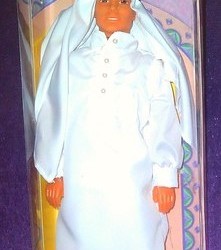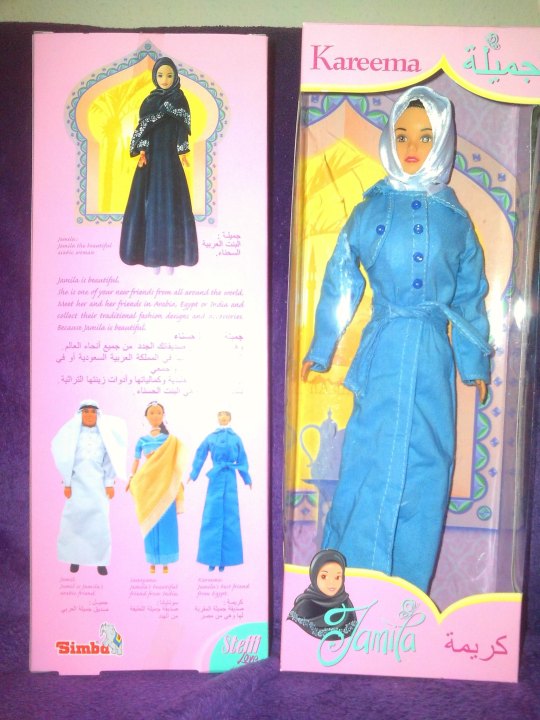#kareema doll
Explore tagged Tumblr posts
Text
Finding information on Jamila wasn't particularly easy, but from what I can gather...
(credit to @eepop-stuffs btw for getting her on my radar!)

Jamila was first released in 2006 by Simba Toys Middle East. According to an article published upon her debut at the 2006 Middle East Toy Fair in Dubai, her prototype initially intended to include fashions representing Turkey, Bangladesh, and Indonesia. However, these concepts never made it to final release, and we unfortunately have no photos of what they would have looked like.

Her initial lineup consisted of four dolls: herself, her male Arabic friend Jamil, her Indian friend Sunayana, and her Egyptian friend Kareema.


The name Jamila means "beautiful", and she seems to have only really been released with one outfit. She wore a black abaya with silver detailing with black shoes, and underneath wore a light blue tanktop with a white pencil skirt. Like her friends Sunayana and Kareema, Jamila has dark hair, brown eyes, and henna on her hands and feet.
(Credit to Bababolond on Flickr for the images)


For those unaware, Henna is a form of body decoration which originated from Africa and the Middle East, used with a natural dye from the Mehendi (lawsonia inermis). It is commonly tied to religious ceremonies such as engagements, weddings, Diwali, and Eid!
For Eid Al-Fitr, Henna would be applied towards the end of Ramadan as a symbol of the earthly delight of being alive. Jamila (and Sunayana if we're to believe they had identical Henna) seems to have eye imagery in hers, which represents protection from evil thoughts or wishes. It's also found on the top of her hands, also symbolizing protection, and on her feet, meant to soothe the nerves.


The name Jamil means "handsome". Jamil was initially released clean-shaven, but it seems later releases gave him facial hair. This might have been around the same time he was changed from Jamila's male friend to her husband, likely because (although opposite-sex friendships aren't explicitly forbidden) certain Muslims worry such friendships might result in inappropriate romantic thoughts. While this doesn't seem to be a unanimous belief across the board (many believing opposite-sex friendships are fine so long as you're careful), it might have caused enough controversy that Simba felt the need to marry the two so there weren't any implications. (Credit to Jan Unwichtig and Bababolond on Flickr for the images)
Ngl tho he is giving me major Kenergy...

Jamil comes with a white Thobe with silver buttons, a white Serwal ( undergarments traditionally worn beneath the Thobe), a white cotton undershirt, a white headscarf known as a Ghutra (tied with a black band called the Egal), black sandals, and a small dagger.
I'm actually not sure why his doll comes with a knife? The closest I could find was the Kirpan: a knife or sword which serves as a reminder to promote justice and protect the weak, mandatory for Amritdhari Sikhs to wear at all times. However, although non-Muslims sometimes confuse the two, Sikhism is a completely separate religion from Islam.
If anyone knows what this knife might be intended to represent, please let me know and I'll reblog an edit to this post!

After they were married, Jamila and Jamil had two children: Asad (meaning "Lion") and Almira (meaning "Princess"), both seen in the first illustration on this post. However, I can only seem to find one doll release for their daughter Almira, and none for Asad. Jamila comes in this playset in her base outfit, while her daughter (who cries when you press her stomach) wears pink pajamas. The playset includes a crib and several plastic accessories, including two hair brushes, a blow drier, and a baby bottle. Not only is this only release for Almira, but this also seems to be the only other release for Jamila aside from her initial core doll.

Sunayana means "woman with lovely eyes". She has long braided black hair, wearing a blue Lehenga Choli with a yellow Dupatta. Like Jamila, she also has henna on her hands and feet. She wears silver bangles, a silver necklace, and what I believe might be a Maang Tikka. Based on her images on the back of the doll boxes, I'm fairly certain she came wearing yellow sandal heels as well!
Honestly she might be one of my favorites of the line, since you sadly don't see many culturally-accurate Indian dolls compared to other ethnic groups. I especially love the use of color, and just how much jewelry she comes with!



Finally we have Jamila's Egyptian friend Kareema, whose name means "generous" or "kind". She has pale pink undergarments painted on beneath her clothes, which I assume Jamila has as well. Weirdly enough, however, she doesn't seem to have Henna like the other two.
Like Sunayana and Jamila she has long black hair, which is kept beneath a white hijab. She wears a long blue overcoat, matching jeans, blue shoes, and a multicolored striped shirt. As far as I can tell, her clothing doesn't seem to have Egyptian cultural roots like Sunayana's has Indian, however her modest style of dress and hijab are common for most Muslim women.
I've been meaning to make this post for at least a full week, and it's nice to finally get to share another beautiful yet obscure Muslim doll! It's a shame this doll didn't have more releases, since I'm honestly curious with the direction the might have taken with her and her friends based on the prior illustration! Regardless, I'm happy I got to share her and her friends with you all :)
Ramadan Kareem!
#FUCKING FINALLY IVE BEEN WAITING FOR SO LONG TO POST THIS#dolls#dollblr#muslim dolls#jamila doll#simba toys#jamil doll#sunayana doll#kareema doll#long post
102 notes
·
View notes
Text
Steffi love mitosis steffi love mitosis steffi love mitosis steffi love mitosis steffi love mitosis steffi
(Srsly though about the Indian dolls thing, the ONLY Indian dolls I've ever been able to find are from this line, I think a few barbie international lines, and Kiyaa, who is dead-)
Finding information on Jamila wasn't particularly easy, but from what I can gather...
(credit to @eepop-stuffs btw for getting her on my radar!)

Jamila was first released in 2006 by Simba Toys Middle East. According to an article published upon her debut at the 2006 Middle East Toy Fair in Dubai, her prototype initially intended to include fashions representing Turkey, Bangladesh, and Indonesia. However, these concepts never made it to final release, and we unfortunately have no photos of what they would have looked like.

Her initial lineup consisted of four dolls: herself, her male Arabic friend Jamil, her Indian friend Sunayana, and her Egyptian friend Kareema.


The name Jamila means "beautiful", and she seems to have only really been released with one outfit. She wore a black abaya with silver detailing with black shoes, and underneath wore a light blue tanktop with a white pencil skirt. Like her friends Sunayana and Kareema, Jamila has dark hair, brown eyes, and henna on her hands and feet.
(Credit to Bababolond on Flickr for the images)


For those unaware, Henna is a form of body decoration which originated from Africa and the Middle East, used with a natural dye from the Mehendi (lawsonia inermis). It is commonly tied to religious ceremonies such as engagements, weddings, Diwali, and Eid!
For Eid Al-Fitr, Henna would be applied towards the end of Ramadan as a symbol of the earthly delight of being alive. Jamila (and Sunayana if we're to believe they had identical Henna) seems to have eye imagery in hers, which represents protection from evil thoughts or wishes. It's also found on the top of her hands, also symbolizing protection, and on her feet, meant to soothe the nerves.


The name Jamil means "handsome". Jamil was initially released clean-shaven, but it seems later releases gave him facial hair. This might have been around the same time he was changed from Jamila's male friend to her husband, likely because (although opposite-sex friendships aren't explicitly forbidden) certain Muslims worry such friendships might result in inappropriate romantic thoughts. While this doesn't seem to be a unanimous belief across the board (many believing opposite-sex friendships are fine so long as you're careful), it might have caused enough controversy that Simba felt the need to marry the two so there weren't any implications. (Credit to Jan Unwichtig and Bababolond on Flickr for the images)
Ngl tho he is giving me major Kenergy...

Jamil comes with a white Thobe with silver buttons, a white Serwal ( undergarments traditionally worn beneath the Thobe), a white cotton undershirt, a white headscarf known as a Ghutra (tied with a black band called the Egal), black sandals, and a small dagger.
I'm actually not sure why his doll comes with a knife? The closest I could find was the Kirpan: a knife or sword which serves as a reminder to promote justice and protect the weak, mandatory for Amritdhari Sikhs to wear at all times. However, although non-Muslims sometimes confuse the two, Sikhism is a completely separate religion from Islam.
If anyone knows what this knife might be intended to represent, please let me know and I'll reblog an edit to this post!

After they were married, Jamila and Jamil had two children: Asad (meaning "Lion") and Almira (meaning "Princess"), both seen in the first illustration on this post. However, I can only seem to find one doll release for their daughter Almira, and none for Asad. Jamila comes in this playset in her base outfit, while her daughter (who cries when you press her stomach) wears pink pajamas. The playset includes a crib and several plastic accessories, including two hair brushes, a blow drier, and a baby bottle. Not only is this only release for Almira, but this also seems to be the only other release for Jamila aside from her initial core doll.

Sunayana means "woman with lovely eyes". She has long braided black hair, wearing a blue Lehenga Choli with a yellow Dupatta. Like Jamila, she also has henna on her hands and feet. She wears silver bangles, a silver necklace, and what I believe might be a Maang Tikka. Based on her images on the back of the doll boxes, I'm fairly certain she came wearing yellow sandal heels as well!
Honestly she might be one of my favorites of the line, since you sadly don't see many culturally-accurate Indian dolls compared to other ethnic groups. I especially love the use of color, and just how much jewelry she comes with!



Finally we have Jamila's Egyptian friend Kareema, whose name means "generous" or "kind". She has pale pink undergarments painted on beneath her clothes, which I assume Jamila has as well. Weirdly enough, however, she doesn't seem to have Henna like the other two.
Like Sunayana and Jamila she has long black hair, which is kept beneath a white hijab. She wears a long blue overcoat, matching jeans, blue shoes, and a multicolored striped shirt. As far as I can tell, her clothing doesn't seem to have Egyptian cultural roots like Sunayana's has Indian, however her modest style of dress and hijab are common for most Muslim women.
I've been meaning to make this post for at least a full week, and it's nice to finally get to share another beautiful yet obscure Muslim doll! It's a shame this doll didn't have more releases, since I'm honestly curious with the direction the might have taken with her and her friends based on the prior illustration! Regardless, I'm happy I got to share her and her friends with you all :)
Ramadan Kareem!
102 notes
·
View notes